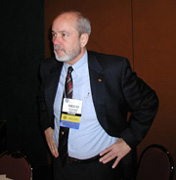
Charlie Culp, a professor at Texas A&M University,
reported on a program for measuring how much emissions a home’s energy
consumption is responsible for.
What if there was a way to determine the amount of emissions a home or commercial building is responsible for? There already is, according to speakers at an American Society of Heating, Refrigerating, and Air-Conditioning Engineers (ASHRAE) seminar, “Big Opportunities for Energy Savings and Emission Reduction.
Charlie Culp, Ph.D., of Texas A&M University, College Station, Texas; Paul Torcellini, Ph.D., of the National Renewable Energy Laboratory (NERL), Golden, Colo.; and Michael Deru, Ph.D., also of the NERL, pointed out that reducing the energy consumption of all types of buildings can reduce emissions of fossil fuel utilities and even reduce smog.



